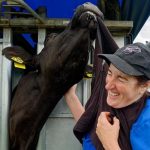
New technology will allow dairy farmers to keep an eye out for lame cows simply by looking at their smartphone, thanks to a camera mounted at the entrance or exit of their shed that feeds the pictures to the cloud and uses artificial intelligence (AI) algorithms to analyse the animals’ gait.
UK startup CattleEye has developed the system using computer vision, a rapidly growing technological area increasingly being harnessed to identify, count and sort anything, including farm animals and horticultural produce.
Amazon Web Services (AWS) worldwide head of solutions architecture for the agriculture industry Karen Hildebrand told attendees at a recent webinar hosted by Agritech New Zealand that computer vision takes the collection of data to another level.
“Agriculture is a data-rich industry, but we all know that vision really makes a difference in understanding what you would do differently. What we talk about is how do we scale vision, how do we see things that the human eye could see but we can’t necessarily scale to a number of humans to be in all locations where we want to see something,” Hildebrand says.
“We ask, ‘what could you do if you could scale your eyesight? What are the problems that you could solve if the constraint of being able to actually physically go there and see with your own eyes is no longer a blocker?’”
CattleEye is just one of hundreds of applications being developed, both in agriculture and other industries.
“They can look from above as the cow moves down an alleyway and detect what the lameness score would be for early interventions,” she says.
“By doing that they can keep the dairy herd more productive because they don’t have lameness, but they’re also able to share that all the way through to the end consumer who wants to be able to feel the animals were raised in a happy and healthy way.”
AWS provides the technology and support for developers with a range of “out of the box solutions” for industry. And for more complex applications, Wellington-based Amazon principal solutions architect Steffen Merten demonstrated how easily a programme could be taught to recognise and count kiwifruit, as well as identifying different varieties.
“Computer vision is one of those things like artificial intelligence, machine learning, big data and the Internet of Things (IoT), where it can seem pretty complicated and difficult to understand. When you lift the bonnet on these technologies there is a lot going on but when it comes down to it, the concepts are relatively simple,” Merten says.
Computer vision, along with the IoT and robotics, is at the heart of a revolutionary way of beekeeping, called BeeWise. Instead of traditional beehives, up to 40 colonies can be housed in one structure where climate and humidity, pest control, swarm prevention and even harvesting are done automatically, with all the information fed back to a smartphone.
“We are not changing how beekeeping is done, we are simply applying it in real-time, with a robotic arm vs a human one,” BeeWise’s website states.
“It’s as if every bee had her own beekeeper 24/7, rain or shine.”

























